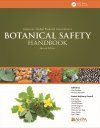![American Herbal Products Association's Botanical Safety Handbook American Herbal Products Association's Botanical Safety Handbook]()
Click to have a closer look
About this book
Contents
Related titles
Recommended titles
About this book
The consumption of herbal products continues to increase, with an estimated sales growth of 10-15 per cent per year projected through the end of the 1990s. As more and more consumers use herbs, it becomes that much more important to ensure that the herbs are used properly and safely. While herbs generally have a safe consumption history, information relevant to specific herbs and particular populations has not been easily available. The Botanical Safety Index Handbook provides readily accessible safety data in an easy-to-use classification system for more than 600 commonly sold herbs. The handbook also features additional information regarding international regulatory status, standard dosage, and certain common toxicity concerns. The editors of this book are among the most respected leaders in the herbal products industry. Their experience includes years of clinical practice, manufacturing and industry governance, and significant writing and lecturing about herbs. The Botanical Safety Index Handbook is for manufacturers of herbal products, health professionals who prescribe herbal remedies, and the consumer. This is a valuable resource for the safe dispensation of herbal products, and will help ensure the safe consumption of herbs through the 1990s and beyond.
Contents
Introduction. Safety Monographs, Alphabetized by Latin Binomial. Appendix 1: Herbal Constituent Profiles. Aristolochic Acid. Atrophine. b-Asarone. Berberine. Cardiac Glycosides. Cyanogenic Glycosides. Estragole. Iodine. Lectins. Oxalates. Pyrrolizidine Alkaloids. Safrole. Salicylates. Tannins. Thujone. Appendix 2: Herbal Action Profiles. Abortifacients. Bulk-Forming Laxatives. Emetics. Emmenagogues/Uterine Stimulants. GI Irritants. MAO Interaction. Nervous System Stimulants. Photosensitizing. Stimulant Laxatives. Appendix 3: Herb Listings by Classification. Herbs for External Use Only (Class 2a). Herbs Not to be Used in Pregnancy (Class 2b). Herbs Not to be Used While Breastfeeding (Class 2c). Herbs Not to be Used Without Expert Supervision (Class 3). Primary References. Bibliography. Plant Index.
Customer Reviews




































